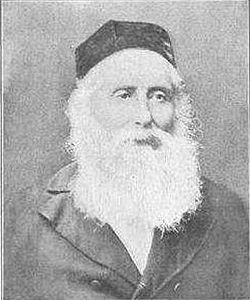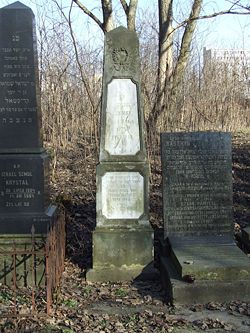
Hayyim Selig Slonimski
Encyclopedia

Astronomer
An astronomer is a scientist who studies celestial bodies such as planets, stars and galaxies.Historically, astronomy was more concerned with the classification and description of phenomena in the sky, while astrophysics attempted to explain these phenomena and the differences between them using...
, inventor, and science author
Author
An author is broadly defined as "the person who originates or gives existence to anything" and that authorship determines responsibility for what is created. Narrowly defined, an author is the originator of any written work.-Legal significance:...
.
Biography
Hayyim Selig Slonimski was born in Byelostok, Russian EmpireRussian Empire
The Russian Empire was a state that existed from 1721 until the Russian Revolution of 1917. It was the successor to the Tsardom of Russia and the predecessor of the Soviet Union...
(modern Białystok, Poland
Poland
Poland , officially the Republic of Poland , is a country in Central Europe bordered by Germany to the west; the Czech Republic and Slovakia to the south; Ukraine, Belarus and Lithuania to the east; and the Baltic Sea and Kaliningrad Oblast, a Russian exclave, to the north...
) March 31, 1810.
When Slonimski was only twenty-four years old he finished writing a textbook on mathematics, but due to lack of funds, only the first part of which was published in 1834 under the title Mosede Ḥokmah.
In 1835 Slonimski released Sefer Kukba di-Shebit (1835), a collection of essays on the Halley comet and other astronomy related topics such as laws of Kepler and Newton
Newton's laws of motion
Newton's laws of motion are three physical laws that form the basis for classical mechanics. They describe the relationship between the forces acting on a body and its motion due to those forces...
. This work significantly increased Slonimiski's popularity, because Halley's comet was widely discussed topic as the return of this periodic comet was expected in 1835.
In 1838 Hayyim Selig Slonimski settled in Warsaw
Warsaw
Warsaw is the capital and largest city of Poland. It is located on the Vistula River, roughly from the Baltic Sea and from the Carpathian Mountains. Its population in 2010 was estimated at 1,716,855 residents with a greater metropolitan area of 2,631,902 residents, making Warsaw the 10th most...
, where he became acquainted with mathematician and inventor Abraham Jacob Stern (1768–1842), later becoming his son-in-law, when in 1842 he married Stern's youngest daughter,
Sarah (1824–1897).
In 1844 he was awarded the part Demidov Prize
Demidov Prize
The Demidov Prize was a national scientific prize in the Russian Empire awarded annually to the members of the Russian Academy of Sciences. One of the most prestigious and oldest scientific awards in the world, its traditions influenced other awards of this kind including the Nobel Prize...
of 2,500 ruble
Ruble
The ruble or rouble is a unit of currency. Currently, the currency units of Belarus, Russia, Abkhazia, South Ossetia and Transnistria, and, in the past, the currency units of several other countries, notably countries influenced by Russia and the Soviet Union, are named rubles, though they all are...
s by Russian Academy of Sciences
Russian Academy of Sciences
The Russian Academy of Sciences consists of the national academy of Russia and a network of scientific research institutes from across the Russian Federation as well as auxiliary scientific and social units like libraries, publishers and hospitals....
for the invention of a calculating machine
Calculating machine
A calculating machine is a machine designed to come up with calculations or, in other words, computations. One noted machine was the Victorian British scientist Charles Babbage's Difference Engine , designed in the 1840s but never completed in the inventor's lifetime...
.
Slonimski lived between 1846 and 1858 in Tomaszów Mazowiecki
Tomaszów Mazowiecki
Tomaszów Mazowiecki is a town in central Poland with 67,159 inhabitants . Situated in the Łódź Voivodeship , it was previously part of Piotrków Trybunalski Voivodeship...
, an industrial town in central Poland
Poland
Poland , officially the Republic of Poland , is a country in Central Europe bordered by Germany to the west; the Czech Republic and Slovakia to the south; Ukraine, Belarus and Lithuania to the east; and the Baltic Sea and Kaliningrad Oblast, a Russian exclave, to the north...
. In 1853 he invented a chemical process for plating iron vessels with lead, and in 1856 an electrochemical device for sending quadruple telegrams. The system of multiple telegraphy perfected by Lord Kelvin in 1858 was based on Slonimski's discovery
In deciding certain scientific questions connected with Jewish matters, Slonimski at times found himself at variance with other Jewish scholars. Thus, despite his conservatism, he admitted that an error of four days' excess had crept into the Hebrew calendar
Hebrew calendar
The Hebrew calendar , or Jewish calendar, is a lunisolar calendar used today predominantly for Jewish religious observances. It determines the dates for Jewish holidays and the appropriate public reading of Torah portions, yahrzeits , and daily Psalm reading, among many ceremonial uses...
cycle as compared with the true solar cycle; in this view he was opposed especially by Joseph Perles
Joseph Perles
-Biography:Perles born in Baja Hungary on November 26, 1835. Having received his early instruction in the Talmud from his father, Baruch Asher Perles, he was educated successively at the gymnasium of his native city, was one of the first rabbis trained at the new type of rabbinical seminary at...
, the controversy being carried on for thirty years. Slonimski likewise discussed the question of the so-called "Jewish date-line" for deciding on which days Shabbat
Shabbat
Shabbat is the seventh day of the Jewish week and a day of rest in Judaism. Shabbat is observed from a few minutes before sunset on Friday evening until a few minutes after when one would expect to be able to see three stars in the sky on Saturday night. The exact times, therefore, differ from...
and holy days should be observed by Jews in the Far East and in Australasia
Australasia
Australasia is a region of Oceania comprising Australia, New Zealand, the island of New Guinea, and neighbouring islands in the Pacific Ocean. The term was coined by Charles de Brosses in Histoire des navigations aux terres australes...
. He argued that for them the line must be fixed not from Greenwich
Greenwich
Greenwich is a district of south London, England, located in the London Borough of Greenwich.Greenwich is best known for its maritime history and for giving its name to the Greenwich Meridian and Greenwich Mean Time...
, but from Jerusalem, the center of the earth according to the Talmud
Talmud
The Talmud is a central text of mainstream Judaism. It takes the form of a record of rabbinic discussions pertaining to Jewish law, ethics, philosophy, customs and history....
. This calculation would make the dividing line pass between China
China
Chinese civilization may refer to:* China for more general discussion of the country.* Chinese culture* Greater China, the transnational community of ethnic Chinese.* History of China* Sinosphere, the area historically affected by Chinese culture...
and Japan
Japan
Japan is an island nation in East Asia. Located in the Pacific Ocean, it lies to the east of the Sea of Japan, China, North Korea, South Korea and Russia, stretching from the Sea of Okhotsk in the north to the East China Sea and Taiwan in the south...
, the former with the Philippines
Philippines
The Philippines , officially known as the Republic of the Philippines , is a country in Southeast Asia in the western Pacific Ocean. To its north across the Luzon Strait lies Taiwan. West across the South China Sea sits Vietnam...
being included in the Far East
Far East
The Far East is an English term mostly describing East Asia and Southeast Asia, with South Asia sometimes also included for economic and cultural reasons.The term came into use in European geopolitical discourse in the 19th century,...
, and the latter in the West .
In 1862 in Warsaw Slonimski established weekly newspaper Ha-Tsefirah
Ha-Tsefirah
Ha-Tsefirah was a Hebrew language newspaper published in 1862 and 1874-1931. -History:...
, which was the first Hebrew organ devoted mainly to scientific subjects. It was published for six months until the same year Slonimski was appointed as principal of the rabbinical seminary in Zhytomyr
Zhytomyr
Zhytomyr is a city in the North of the western half of Ukraine. It is the administrative center of the Zhytomyr Oblast , as well as the administrative center of the surrounding Zhytomyr Raion...
and as government censor of Hebrew books, positions which he held till the seminary was closed by the Russian government in 1874 .
Slonimski resumed the publication of Ha-Tsefirah
Ha-Tsefirah
Ha-Tsefirah was a Hebrew language newspaper published in 1862 and 1874-1931. -History:...
at Berlin
Berlin
Berlin is the capital city of Germany and is one of the 16 states of Germany. With a population of 3.45 million people, Berlin is Germany's largest city. It is the second most populous city proper and the seventh most populous urban area in the European Union...
the same year, changing the place of publication to Warsaw in September 1875.
Hayyim Selig Slonimski died in Warsaw on May 15, 1904.

Major works
- Mosede Ḥokmah (1834), on the fundamental principles of higher algebra
- Sefer Kukba di-Shebit (1835), essays on the Halley comet and on astronomy in general
- Toledot ha-Shamayim (1838), on astronomy and optics
- Yesode ha-'Ibbur (1852), on the Jewish calendar system and its history
- Meẓi'ut ha-Nefesh we-Ḳiyyumah (1852), on of the immortality of the soul
- Ot Zikkaron (1858), a biographical sketch of Alexander von HumboldtAlexander von HumboldtFriedrich Wilhelm Heinrich Alexander Freiherr von Humboldt was a German naturalist and explorer, and the younger brother of the Prussian minister, philosopher and linguist Wilhelm von Humboldt...

